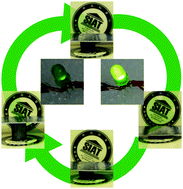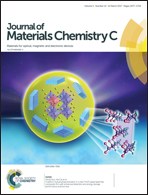Fabrication of highly reinforced and compressible graphene/carbon nanotube hybrid foams via a facile self-assembly process for application as strain sensors and beyond†
Abstract
Three-dimensional (3D) compressible carbon-based foams with ultralow density, high porosity and excellent electrical conductivity have aroused considerable interest especially as pressure sensors, recyclable absorbents and for other advanced applications. Herein, highly compressible 3D graphene/carbon nanotube foams (GCFs) were prepared by a facile self-assembly process under mild conditions. The incorporation of CNTs into graphene resulted in great improvement of their mechanical and compressible properties compared with the graphene-only foam (under a high strain of 80% and a higher stress of 25.64 kPa). Besides, the GCFs exhibited excellent piezoresistive properties with high sensitivity (with a high gauge factor of 8.4 at a strain of 10%) and great stability during the compression cycles which was quite important for the pressure sensors. In addition, the compressible GCFs also possessed excellent adsorption capacity for organic solvents with great reusability. With unique electrical features and high sensitivity as well as robust mechanical strength, the as-fabricated 3D GCFs possess great potential as elastic pressure sensor materials, absorbents and beyond.



 Please wait while we load your content...
Please wait while we load your content...